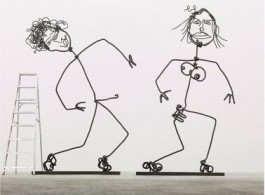Tim Noble (b. Stroud, 1966) and Sue Webster (b. Leicester, 1967) met at art school in Nottingham, England in1986, when they both arrived a day late for enrolment.
Inspired by the work of Damien Hirst and other Young British Artists, they moved to London and worked for the artist duo Gilbert and George. Noble and Webster started to make work together in 1996, but with very little money and resources, they began to use personal items and household rubbish as their main materials. It was then that they developed their first shadow sculptures, a signature technique that would catapult them to stardom.
These detailed self-portraits were made with shadows that were cast by shining light onto carefully arranged piles of rubbish. In their first shadow sculpture, Miss Understood & Mr Meanor, what at first appears to be two indistinct clumps of discarded objects, reveals a perfect likeness of the artists’ heads, cast in shadow once the light is turned on.
Alongside this, they made sculptures using lighting such as neon and flashing electrical bulbs, from fairgrounds and amusement arcades.
They presented the shadow sculptures and the light works in a landmark solo exhibition, Home Chance, which they staged in their apartment in London. The exhibition attracted a great deal of attention, including the renowned British collector, Charles Saatchi, who bought the whole show and shot them to fame.
The artists continued to produce an increasingly complex and impressive range of sculpture that is today included in many of the world’s leading museums and collections including Artis-François Pinault, Paris; The British Museum, London; DakisJoannou Collection, Athens; Didier Casimiro Collection, Vilvoorde; Nicola Erni Collection, Zug; Guggenheim Museum, New York; Museum of Contemporary Art, Los Angeles; National Portrait Gallery, London; The Olbricht Collection, Berlin; Saatchi Collection, London; Leeum, Samsung Museum of Art, Seoul; and The Zabludowicz Collection, London.
Part of a great tradition of artists-as-art, their personal image is an integral part of their work. As much as they have used refuse in their sculptures, the artists employ their own naked forms as a way to make art with a rawness and truth, using their warts-and-all inseparable dual image. As with the punk bands who had such an effect on the artists, what defines this duo is a drive to convey a particularly British reality, pushing against the polished veneer of the presiding culture. Their systems of imagery and language are as confrontational as early punk gigs and – as with this music – the artists play with the tensions of structure and form, purposefully teetering on the edge of chaos.
As in their shadow works, ideas of positive and negative images are a consistent theme across all of their work.
Look closely at these sculptures and accurate profiles of the artists can be seen in the negative space.
The artist’s newest body of sculpture was recently revealed at Blain |Southern London. The duo presented pairs of giant stick figure self portraits sculpted in twisted bronze, an entirely new method for the artists. Based on handmade maquettes made with electrical wire, the sculptures are an act of upscaling playful ephemera into physically domineering artworks with a permanency and scale that transcends human limitations.
The size, medium and aesthetic of their new sculptures are yet another bold development in a practice that Noble describes as ‘consistently inconsistent.’ Although at first these sculptures seem to be radical departure from previous methods, their shadow works are lightly referenced and ideas of positive and negative space are strongly present in their use of the traditonal ‘lost wax’ process of casting. Working at a scale that seems to contradict the materials, the artists achieve the sketchy, continuous effect of wire by employing the traditional technique of lost wax casting where manipulated rods of wax are replaced by molten bronze. The resulting casts retain the spontaneity of the sculptor’s hands, and remain humanised and true to the subject. The dimensional qualities vary between each pair yet they are united by a fluidity and lightness of gesture that is rare to see in large-scale sculpture.



